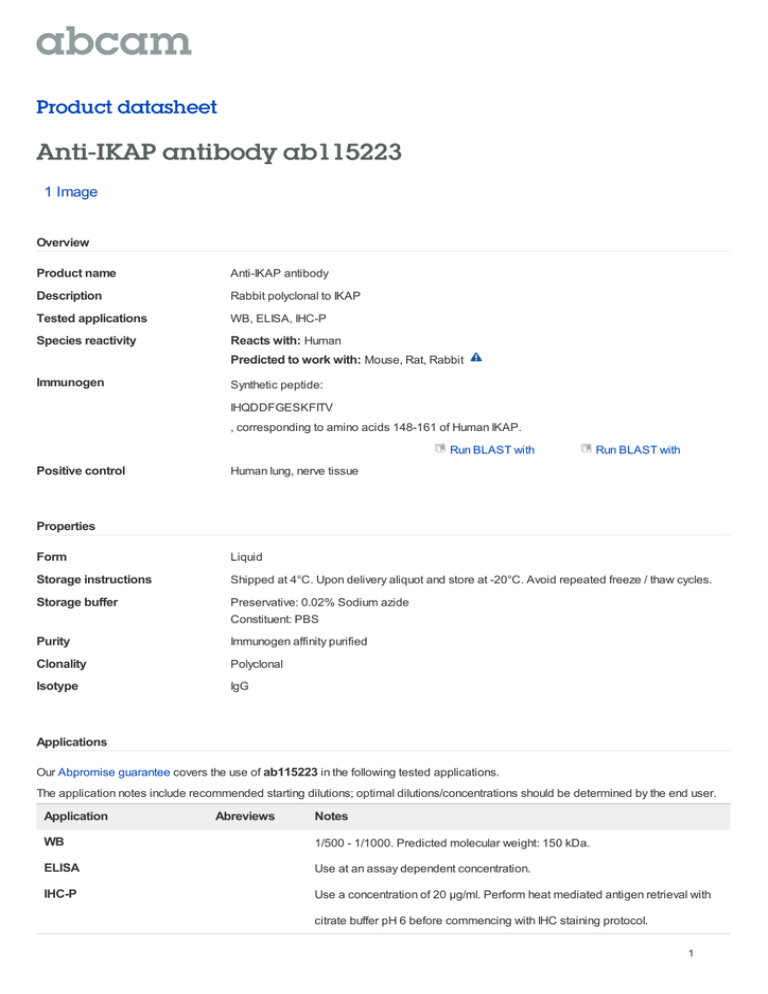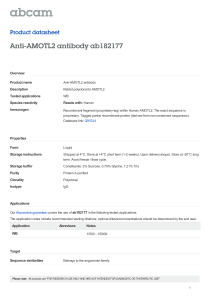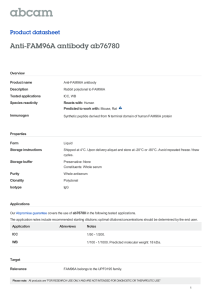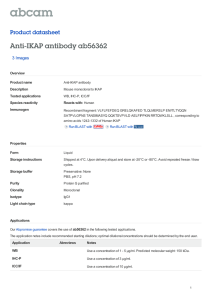Anti-IKAP antibody ab115223 Product datasheet 1 Image
advertisement

Product datasheet Anti-IKAP antibody ab115223 1 Image Overview Product name Anti-IKAP antibody Description Rabbit polyclonal to IKAP Tested applications WB, ELISA, IHC-P Species reactivity Reacts with: Human Predicted to work with: Mouse, Rat, Rabbit Immunogen Synthetic peptide: IHQDDFGESKFITV , corresponding to amino acids 148-161 of Human IKAP. Run BLAST with Positive control Run BLAST with Human lung, nerve tissue Properties Form Liquid Storage instructions Shipped at 4°C. Upon delivery aliquot and store at -20°C. Avoid repeated freeze / thaw cycles. Storage buffer Preservative: 0.02% Sodium azide Constituent: PBS Purity Immunogen affinity purified Clonality Polyclonal Isotype IgG Applications Our Abpromise guarantee covers the use of ab115223 in the following tested applications. The application notes include recommended starting dilutions; optimal dilutions/concentrations should be determined by the end user. Application Abreviews Notes WB 1/500 - 1/1000. Predicted molecular weight: 150 kDa. ELISA Use at an assay dependent concentration. IHC-P Use a concentration of 20 µg/ml. Perform heat mediated antigen retrieval with citrate buffer pH 6 before commencing with IHC staining protocol. 1 Target Function May act as a scaffold protein that may assemble active IKK-MAP3K14 complexes (IKKA, IKKB and MAP3K14/NIK). Acts as subunit of the RNA polymerase II elongator complex, which is a histone acetyltransferase component of the RNA polymerase II (Pol II) holoenzyme and is involved in transcriptional elongation. Elongator may play a role in chromatin remodeling and is involved in acetylation of histones H3 and probably H4. Involvement in disease Defects in IKBKAP are the cause of hereditary sensory and autonomic neuropathy type 3 (HSAN3) [MIM:223900]; also known as Riley-Day syndrome or familial dysautonomia (FD). This autosomal recessive disorder is due to the poor development and survival, and progressive degeneration of the sensory, sympathetic and parasympathetic neurons. HSAN3 individuals are affected with a variety of symptoms such as decreased sensitivity to pain and temperature, cardiovascular instability, recurrent pneumonias, vomiting crises, and gastrointestinal dysfunction. It is primarily confined to individuals of Ashkenazi Jewish descent, with an incidence of 1/3'600 live births. Sequence similarities Belongs to the ELP1/IKA1 family. Cellular localization Cytoplasm. Nucleus. Anti-IKAP antibody images Staining of IKAP in Human lung, nerve tissue (formalin fixed, paraffin embedded), using ab115223 at 20 µg/ml followed by biotinylated Goat anti Rabbit IgG secondary antibody, alkaline phosphatase streptavidin and chromogen. Immunohistochemistry (Formalin/PFA-fixed paraffin-embedded sections) - Anti-IKAP antibody (ab115223) Please note: All products are "FOR RESEARCH USE ONLY AND ARE NOT INTENDED FOR DIAGNOSTIC OR THERAPEUTIC USE" Our Abpromise to you: Quality guaranteed and expert technical support Replacement or refund for products not performing as stated on the datasheet Valid for 12 months from date of delivery Response to your inquiry within 24 hours We provide support in Chinese, English, French, German, Japanese and Spanish Extensive multi-media technical resources to help you We investigate all quality concerns to ensure our products perform to the highest standards If the product does not perform as described on this datasheet, we will offer a refund or replacement. For full details of the Abpromise, 2 please visit http://www.abcam.com/abpromise or contact our technical team. Terms and conditions Guarantee only valid for products bought direct from Abcam or one of our authorized distributors 3



